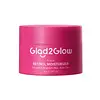What's inside
What's inside
 Key Ingredients
Key Ingredients

 Benefits
Benefits

 Concerns
Concerns

 Ingredients Side-by-side
Ingredients Side-by-side

Water
Skin ConditioningPotassium Cocoyl Glycinate
Hydrogenated Starch Hydrolysate
HumectantAcrylates/Steareth-20 Methacrylate Crosspolymer
Centella Asiatica Extract
CleansingPotassium Cocoate
EmulsifyingSalicylic Acid
MaskingSodium Lauroamphoacetate
CleansingLauryl Hydroxysultaine
CleansingErythritol
HumectantCaprylyl Glycol
EmollientPotassium Hydroxide
BufferingSodium Chloride
MaskingDisodium EDTA
Glycosyl Trehalose
Emulsion StabilisingHydroxypropyl Cyclodextrin
MaskingAroma
Phenoxyethanol
PreservativeWater, Potassium Cocoyl Glycinate, Hydrogenated Starch Hydrolysate, Acrylates/Steareth-20 Methacrylate Crosspolymer, Centella Asiatica Extract, Potassium Cocoate, Salicylic Acid, Sodium Lauroamphoacetate, Lauryl Hydroxysultaine, Erythritol, Caprylyl Glycol, Potassium Hydroxide, Sodium Chloride, Disodium EDTA, Glycosyl Trehalose, Hydroxypropyl Cyclodextrin, Aroma, Phenoxyethanol
Water
Skin ConditioningDimethicone
EmollientHydroxyethyl Urea
HumectantGlycerin
HumectantIsododecane
EmollientNiacinamide
SmoothingGlycereth-26
HumectantTrehalose
HumectantButylene Glycol
HumectantAllantoin
Skin ConditioningPhenoxyethanol
PreservativeAcrylates/C10-30 Alkyl Acrylate Crosspolymer
Emulsion StabilisingTromethamine
BufferingPolyglyceryl-6 Distearate
EmulsifyingHydrogenated Lecithin
EmulsifyingRetinol
Skin ConditioningDimethiconol
EmollientMethylparaben
PreservativePrunus Persica Fruit Extract
AbrasivePolyacrylate Crosspolymer-6
Emulsion StabilisingCarbomer
Emulsion StabilisingJojoba Esters
EmollientHexyldecanol
EmollientGlyceryl Glucoside
HumectantAmmonium Acryloyldimethyltaurate/Vp Copolymer
Ethylhexylglycerin
Skin ConditioningCetyl Alcohol
EmollientPolyglyceryl-3 Beeswax
EmulsifyingCeramide NP
Skin ConditioningPropanediol
SolventPentylene Glycol
Skin ConditioningCholesterol
EmollientAvena Sativa Kernel Extract
AbrasiveAroma
Chlorella Vulgaris Extract
Skin ConditioningLactic Acid
BufferingCentella Asiatica Flower/Leaf/Stem Extract
Skin ConditioningMatrine
AntioxidantEctoin
Skin ConditioningHydroxypinacolone Retinoate
Skin ConditioningHydroxyethylpiperazine Ethane Sulfonic Acid
BufferingAdenosine
Skin ConditioningCI 19140
Cosmetic ColorantWater, Dimethicone, Hydroxyethyl Urea, Glycerin, Isododecane, Niacinamide, Glycereth-26, Trehalose, Butylene Glycol, Allantoin, Phenoxyethanol, Acrylates/C10-30 Alkyl Acrylate Crosspolymer, Tromethamine, Polyglyceryl-6 Distearate, Hydrogenated Lecithin, Retinol, Dimethiconol, Methylparaben, Prunus Persica Fruit Extract, Polyacrylate Crosspolymer-6, Carbomer, Jojoba Esters, Hexyldecanol, Glyceryl Glucoside, Ammonium Acryloyldimethyltaurate/Vp Copolymer, Ethylhexylglycerin, Cetyl Alcohol, Polyglyceryl-3 Beeswax, Ceramide NP, Propanediol, Pentylene Glycol, Cholesterol, Avena Sativa Kernel Extract, Aroma, Chlorella Vulgaris Extract, Lactic Acid, Centella Asiatica Flower/Leaf/Stem Extract, Matrine, Ectoin, Hydroxypinacolone Retinoate, Hydroxyethylpiperazine Ethane Sulfonic Acid, Adenosine, CI 19140
 Reviews
Reviews

Ingredients Explained
These ingredients are found in both products.
Ingredients higher up in an ingredient list are typically present in a larger amount.
Aroma refers to an ingredient, or mixture of ingredients, that impart or mask a flavor.
The name is slightly confusing. This is because INCI associates aroma with flavor instead of smell.
Here is the official definition from the The International Cosmetic Ingredient Dictionary and Handbook:
“Aroma is a term for ingredient labeling used to identify that a product contains a material or combination of materials normally added to a cosmetic to produce or to mask a particular flavor.”
INCI shows the only purpose of aroma to be "flavouring".
However, due to regulation differences, some companies may use aroma in place of parfum.
In Canada, this ingredient only has to be listed in concentrations above 1%.
Learn more about AromaPhenoxyethanol is a preservative that has germicide, antimicrobial, and aromatic properties. Studies show that phenoxyethanol can prevent microbial growth. By itself, it has a scent that is similar to that of a rose.
It's often used in formulations along with Caprylyl Glycol to preserve the shelf life of products.
Water. It's the most common cosmetic ingredient of all. You'll usually see it at the top of ingredient lists, meaning that it makes up the largest part of the product.
So why is it so popular? Water most often acts as a solvent - this means that it helps dissolve other ingredients into the formulation.
You'll also recognize water as that liquid we all need to stay alive. If you see this, drink a glass of water. Stay hydrated!
Learn more about Water